Apple
| Apple | ||||||||||||||||||
|---|---|---|---|---|---|---|---|---|---|---|---|---|---|---|---|---|---|---|
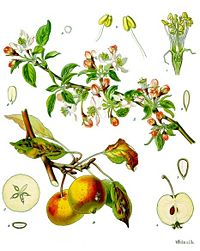 Blossoms, fruits, and leaves of the apple tree (Malus domestica)
|
||||||||||||||||||
| Scientific classification | ||||||||||||||||||
|
||||||||||||||||||
| Binomial name | ||||||||||||||||||
| Malus domestica Borkh. |
The apple is the pomaceous fruit of the apple tree, species Malus domestica in the rose family Rosaceae. It is one of the most widely cultivated tree fruits. The tree is small and deciduous, reaching 3 to 12 metres (9.8 to 39 ft) tall, with a broad, often densely twiggy crown.[1] The leaves are alternately arranged simple ovals 5 to 12 cm long and 3–6 centimetres (1.2–2.4 in) broad on a 2 to 5 centimetres (0.79 to 2.0 in) petiole with an acute tip, serrated margin and a slightly downy underside. Blossoms are produced in spring simultaneously with the budding of the leaves. The flowers are white with a pink tinge that gradually fades, five petaled, and 2.5 to 3.5 centimetres (0.98 to 1.4 in) in diameter. The fruit matures in autumn, and is typically 5 to 9 centimetres (2.0 to 3.5 in) diameter. The center of the fruit contains five carpels arranged in a five-point star, each carpel containing one to three seeds.[1]
The tree originated from Central Asia, where its wild ancestor is still found today. There are more than 7,500 known cultivars of apples resulting in range of desired characteristics. Cultivars vary in their yield and the ultimate size of the tree, even when grown on the same rootstock.[2]
At least 55 million tonnes of apples were grown worldwide in 2005, with a value of about $10 billion. China produced about 35% of this total.[3] The United States is the second leading producer, with more than 7.5% of the world production. Turkey, France, Italy and Iran are among the leading apple exporters.
Contents |
Botanical information
- See also: List of Lepidoptera that feed on apple trees and Fruit tree propagation
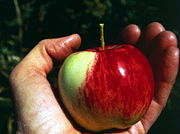
The wild ancestor of Malus domestica is Malus sieversii. It has no common name in English, but is known in Kazakhstan, where it is native, as alma; in fact, the region where it is thought to originate is called Almaty, or "reach of the apples". This tree is still found wild in the mountains of Central Asia in southern Kazakhstan, Kyrgyzstan, Tajikistan, and Xinjiang, China.[4]
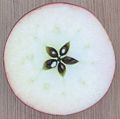
For many years, there was a debate about whether M. domestica evolved from chance hybridization among various wild species. Recent DNA analysis by Barrie Juniper, Emeritus Fellow in the Department of Plant Sciences at Oxford University and others, has indicated, however, that the hybridization theory is probably false. Instead, it appears that a single species still growing in the Ili Valley, on the northern slopes of the Tien Shan mountains at the border of Northwest China[5] and Kazakhstan, is the progenitor of the apples eaten today. Leaves taken from trees in this area were analyzed for DNA composition, which showed them all to belong to the species M. sieversii, with some genetic sequences common to M. domestica.[6] Other species that were previously thought to have made contributions to the genome of the domestic apples are Malus baccata and Malus sylvestris, but there is no hard evidence for this in older apple cultivars. These and other Malus species have been used in some recent breeding programmes to develop apples suitable for growing in climates unsuitable for M. domestica, mainly for increased cold tolerance.[7]
History
- See also: Herefordshire Pomona
The center of diversity of the genus Malus is the eastern Turkey. The apple tree was perhaps the earliest tree to be cultivated,[8] and its fruits have been improved through selection over thousands of years. Alexander the Great is credited with finding dwarfed apples in Asia Minor in 300 BCE;[1] those he brought back to Macedonia might have been the progenitors of dwarfing rootstocks. Winter apples, picked in late autumn and stored just above freezing, have been an important food in Asia and Europe for millennia, as well as in Argentina and in the United States since the arrival of Europeans.[8] Apples were brought to North America with colonists in the 1600s,[1] and the first apple orchard on the North American continent was said to be near Boston in 1625. In the 1900s, irrigation projects in Washington state began and allowed the development of the multi-billion dollar fruit industry, of which the apple is the leading species.[1]
Cultural aspects
Germanic paganism

In Norse mythology, the goddess Iðunn is portrayed in the Prose Edda (written in the 13th century by Snorri Sturluson) as providing apples to the gods that give them eternal youthfulness. English scholar H. R. Ellis Davidson links apples to religious practices in Germanic paganism, from which Norse paganism developed. She points out that buckets of apples were found in the Oseberg ship burial site in Norway and that fruit and nuts (Iðunn having been described as being transformed into a nut in Skáldskaparmál) have been found in the early graves of the Germanic peoples in England and elsewhere on the continent of Europe which may have had a symbolic meaning, and that nuts are still a recognized symbol of fertility in Southwest England.[9]
Davidson notes a connection between apples and the Vanir, a tribe of gods associated with fertility in Norse mythology, citing an instance of eleven "golden apples" being given to woo the beautiful Gerðr by Skírnir, who was acting as messenger for the major Vanir god Freyr in stanzas 19 and 20 of Skírnismál. Davidson also notes a further connection between fertility and apples in Norse mythology in chapter 2 of the Völsunga saga when the major goddess Frigg sends King Rerir an apple after he prays to Odin for a child, Frigg's messenger (in the guise of a crow) drops the apple in his lap as he sits atop a mound.[10] Rerir's wife's consumption of the apple results in a six-year pregnancy and the caesarean section birth of their son - the hero Völsung.[11]
Further, Davidson points out the "strange" phrase "Apples of Hel" used in an 11th-century poem by the skald Thorbiorn Brúnarson, she states this may imply that the apple was thought of by the skald as the food of the dead. Further, Davidson notes that the potentially Germanic goddess Nehalennia is sometimes depicted with apples and that parallels exist in early Irish stories. Davidson asserts that while cultivation of the apple in Northern Europe extends back to at least the time of the Roman Empire and came to Europe from the Near East, the native varieties of apple trees growing in Northern Europe are small and bitter. Davidson concludes that in the figure of Iðunn "we must have a dim reflection of an old symbol: that of the guardian goddess of the life-giving fruit of the other world."[9]
Greek mythology
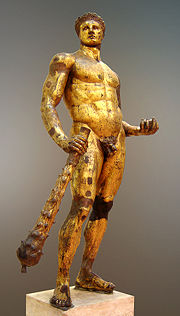
Apples appear in many religious traditions, often as a mystical or forbidden fruit. One of the problems identifying apples in religion, mythology and folktales is that the word "apple" was used as a generic term for all (foreign) fruit, other than berries but including nuts, as late as the 17th century.[7] For instance, in Greek mythology, the Greek hero Heracles, as a part of his Twelve Labours, was required to travel to the Garden of the Hesperides and pick the golden apples off the Tree of Life growing at its center.[12][13][14]
The Greek goddess of discord, Eris, became disgruntled after she was excluded from the wedding of Peleus and Thetis.[15] In retaliation, she tossed a golden apple inscribed Καλλιστή (Kalliste, sometimes transliterated Kallisti, 'For the most beautiful one'), into the wedding party. Three goddesses claimed the apple: Hera, Athena, and Aphrodite. Paris of Troy was appointed to select the recipient. After being bribed by both Hera and Athena, Aphrodite tempted him with the most beautiful woman in the world, Helen of Sparta. He awarded the apple to Aphrodite, thus indirectly causing the Trojan War.

Atalanta, also of Greek mythology, raced all her suitors in an attempt to avoid marriage. She outran all but Hippomenes (a.k.a. Melanion, a name possibly derived from melon the Greek word for both "apple" and fruit in general),[13] who defeated her by cunning, not speed. Hippomenes knew that he could not win in a fair race, so he used three golden apples (gifts of Aphrodite, the goddess of love) to distract Atalanta. It took all three apples and all of his speed, but Hippomenes was finally successful, winning the race and Atalanta's hand.[12]
Christianity
Though the forbidden fruit in the Book of Genesis is not identified, popular Christian tradition has held that it was an apple that Eve coaxed Adam to share with her.[16] This may have been the result of Renaissance painters adding elements of Greek mythology into biblical scenes. In this case the unnamed fruit of Eden became an apple under the influence of story of the golden apples in the Garden of Hesperides. As a result, in the story of Adam and Eve the apple became a symbol for knowledge, immortality, temptation, the fall of man into sin, and sin itself. In Latin, the words for "apple" and for "evil" are similar in the singular (malus—apple, malum—evil) and identical in the plural (mala). This may also have influenced the apple becoming interpreted as the biblical "forbidden fruit". The larynx in the human throat has been called Adam's apple because of a notion that it was caused by the forbidden fruit sticking in the throat of Adam.[16] The apple as symbol of sexual seduction has been used to imply sexuality between men, possibly in an ironic vein.[16] The idea of an apple being the fruit of the Tree of the Knowledge of Good and Evil with English speakers may have been helped by the fact that apple could also be a generic word for fruit in Old English, the word being used in various commentaries on Genesis.
Apple cultivars
- See List of apple cultivars for a listing.
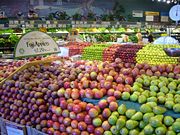
There are more than 7,500 known cultivars of apples. Different cultivars are available for temperate and subtropical climates. Reputedly the world's biggest collection of apple cultivars is housed at the National Fruit Collection in England.[2] Most of these cultivars are bred for eating fresh (dessert apples), though some are cultivated specifically for cooking (cooking apples) or producing cider. Cider apples are typically too tart and astringent to eat fresh, but they give the beverage a rich flavour that dessert apples cannot.[17]
Commercially popular apple cultivars are soft but crisp. Other desired qualities in modern commercial apple breeding are a colourful skin, absence of russeting, ease of shipping, lengthy storage ability, high yields, disease resistance, typical "Red Delicious" apple shape, long stem (to allow pesticides to penetrate the top of the fruit), and popular flavour.[2] Modern apples are generally sweeter than older cultivars, as popular tastes in apples have varied over time. Most North Americans and Europeans favour sweet, subacid apples, but tart apples have a strong minority following.[18] Extremely sweet apples with barely any acid flavour are popular in Asia[18] and especially India.[17]
Old cultivars are often oddly shaped, russeted, and have a variety of textures and colours. Some find them to have a better flavour than modern cultivators,[19] but may have other problems which make them commercially unviable, such as low yield, liability to disease, or poor tolerance for storage or transport. A few old cultivars are still produced on a large scale, but many have been kept alive by home gardeners and farmers that sell directly to local markets. Many unusual and locally important cultivars with their own unique taste and appearance exist; apple conservation campaigns have sprung up around the world to preserve such local cultivars from extinction. In the United Kingdom old cultivars such as Cox's Orange Pippin and Egremont Russett are still commercially important even though by modern standards they are low yielding and disease prone.[1]
Apple production
Apple breeding
Like most perennial fruits, apples ordinarily propagate asexually by grafting. Seedling apples are an example of "Extreme heterozygotes", in that rather than inheriting DNA from their parents to create a new apple with those characteristics, they are instead different from their parents, sometimes radically.[20] Most new apple cultivars originate as seedlings, which either arise by chance or are bred by deliberately crossing cultivars with promising characteristics.[21] The words 'seedling', 'pippin', and 'kernel' in the name of an apple cultivar suggest that it originated as a seedling. Apples can also form bud sports (mutations on a single branch). Some bud sports turn out to be improved strains of the parent cultivar. Some differ sufficiently from the parent tree to be considered new cultivars.[22]
Breeders can produce more rigid apples through crossing.[23] For example, the Excelsior Experiment Station of the University of Minnesota has, since the 1930s, introduced a steady progression of important hardy apples that are widely grown, both commercially and by backyard orchardists, throughout Minnesota and Wisconsin. Its most important introductions have included 'Haralson' (which is the most widely cultivated apple in Minnesota), 'Wealthy', 'Honeygold', and 'Honeycrisp'.
Apples have been acclimatized in Ecuador at very high altitudes, where they provide crops twice per year because of constant temperate conditions in a whole year.[24]
Pollination
- See also: Fruit tree pollination
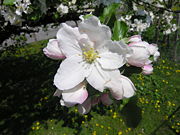
Apples are self-incompatible; they must cross-pollinate to develop fruit. During the flowering each season, apple growers usually provide pollinators to carry the pollen. Honeybee hives are most commonly used. Orchard mason bees are also used as supplemental pollinators in commercial orchards. Bumble bee queens are sometimes present in orchards, but not usually in enough quantity to be significant pollinators.[22]
There are four to seven pollination groups in apples depending on climate:
- Group A – Early flowering, May 1 to 3 in England (Gravenstein, Red Astrachan)
- Group B – May 4 to 7 (Idared, McIntosh)
- Group C – Mid-season flowering, May 8 to 11 (Granny Smith, Cox's Orange Pippin)
- Group D – Mid/Late season flowering, May 12 to 15 (Golden Delicious, Calville blanc d'hiver)
- Group E – Late flowering, May 16 to 18 (Braeburn, Reinette d'Orléans)
- Group F – May 19 to 23 (Suntan)
- Group H – May 24 to 28 (Court-Pendu Gris) (also called Court-Pendu plat)
One cultivar can be pollinated by a compatible cultivar from the same group or close (A with A, or A with B, but not A with C or D).[25]
Maturation and harvest
- See also: Apple picking and Pruning fruit trees
Cultivars vary in their yield and the ultimate size of the tree, even when grown on the same rootstock. Some cultivars, if left unpruned, will grow very large, which allows them to bear much more fruit, but makes harvesting very difficult. Mature trees typically bear 40–200 kilograms (88–440 lb) of apples each year, though productivity can be close to zero in poor years. Apples are harvested using three-point ladders that are designed to fit amongst the branches. Dwarf trees will bear about 10–80 kilograms (22–180 lb) of fruit per year.[22]
Storage
Commercially, apples can be stored for some months in controlled-atmosphere chambers to delay ethylene-induced onset of ripening. Ripening begins when the fruit is removed.[26] For home storage, most varieties of apple can be stored for approximately two weeks, when kept at the coolest part of the refrigerator (i.e. below 5°C). Some types of apple, including the Granny Smith and Fuji, have an even longer shelf life.[27]
Pests and diseases
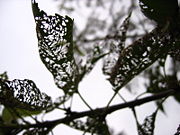
The trees are susceptible to a number of fungal and bacterial diseases and insect pests. Many commercial orchards pursue an aggressive program of chemical sprays to maintain high fruit quality, tree health, and high yields. A trend in orchard management is the use of organic methods. These use a less aggressive and direct methods of conventional farming. Instead of spraying potent chemicals, often shown to be potentially dangerous and maleficent to the tree in the long run, organic methods include encouraging or discouraging certain cycles and pests. To control a specific pest, organic growers might encourage the prosperity of its natural predator instead of outright killing it, and with it the natural biochemistry around the tree. Organic apples generally have the same or greater taste than conventionally grown apples, with reduced cosmetic appearances.[28]
A wide range of pests and diseases can affect the plant; three of the more common diseases/pests are mildew, aphids and apple scab.
- Mildew: which is characterized by light grey powdery patches appearing on the leaves, shoots and flowers, normally in spring. The flowers will turn a creamy yellow colour and will not develop correctly. This can be treated in a manner not dissimilar from treating Botrytis; eliminating the conditions which caused the disease in the first place and burning the infected plants are among the recommended actions to take.[29][29]
- Aphids: There are five species of aphids commonly found on apples: apple grain aphid, rosy apple aphid, apple aphid, spirea aphid and the woolly apple aphid. The aphid species can be identified by their colour, the time of year when they are present and by differences in the cornicles, which are small paired projections from the rear of aphids.[29] Aphids feed on foliage using needlelike mouthparts to suck out plant juices. When present in high numbers, certain species may reduce tree growth and vigor.[30]
- Apple scab: Symptoms of Scab are olive-green or brown blotches on the leaves.[31] The blotches turn more brown as time progresses. Then brown scabs on the fruit (see apple picture on the left).[29] The diseased leaves will fall early and the fruit will become increasingly covered in scabs - eventually the fruit skin will crack. Although there are chemicals to treat Scab, their use might not be encouraged as they are quite often systematic, which means they are absorbed by the tree, and spread throughout the fruit.[31]
Among the most serious disease problems are fireblight, a bacterial disease; and Gymnosporangium rust, and black spot, two fungal diseases.[30]
Young apple trees are also prone to mammal pests like mice and deer, which feed on the soft bark of the trees, especially in winter.
Commerce
At least 55 million tonnes of apples were grown worldwide in 2005, with a value of about $10 billion. China produced about two-fifths of this total.[5] United States is the second leading producer, with more than 7.5% of the world production. Turkey, France, Italy and Iran are among the leading apple exporters.[21]
In the United States, more than 60% of all the apples sold commercially are grown in Washington state.[32] Imported apples from New Zealand and other more temperate areas are competing with US production and increasing each year.[5]
Most of Australia's apple production is for domestic consumption. Imports from New Zealand have been disallowed under quarantine regulations for fire blight since 1921.[33]
| Top Ten Apple Producers — 11 June 2008 | ||||
|---|---|---|---|---|
| Country | Production (Tonnes) | Footnote | ||
| 27507000 | F | |||
| 4237730 | ||||
| 2660000 | F | |||
| 2266437 | ||||
| 2211000 | F | |||
| 2072500 | ||||
| 2001400 | ||||
| 1800000 | F | |||
| 1390000 | F | |||
| 1300000 | F | |||
| 64255520 | A | |||
| No symbol = official figure, P = official figure, F = FAO estimate, * = Unofficial/Semi-official/mirror data, C = Calculated figure A = Aggregate(may include official, semi-official or estimates); |
||||
Human consumption
- See also: Cooking apple and Cider apple
Apples can be canned, juiced, and optionally fermented to produce apple juice, cider, ciderkin, vinegar, and pectin. Distilled apple cider produces the spirits applejack and Calvados. Apple wine can also be made. They make a popular lunchbox fruit as well.[34]
Apples are an important ingredient in many desserts, such as apple pie, apple crumble, apple crisp and apple cake. They are often eaten baked or stewed, and they can also be dried and eaten or re-constituted (soaked in water, alcohol or some other liquid) for later use. Puréed apples are generally known as apple sauce. Apples are also made into apple butter and apple jelly. They are also used (cooked) in meat dishes.
- In the UK, a toffee apple is a traditional confection made by coating an apple in hot toffee and allowing it to cool. Similar treats in the US are candy apples (coated in a hard shell of crystallised sugar syrup), and caramel apples, coated with cooled caramel.
- Apples are eaten with honey at the Jewish New Year of Rosh Hashanah to symbolize a sweet new year.[34]
- Farms with apple orchards may open them to the public, so consumers may themselves pick the apples they will buy.[34]
Sliced apples turn brown with exposure to air due to the conversion of natural phenolic substances into melanin upon exposure to oxygen.[35] Different cultivars differ in their propensity to brown after slicing. Sliced fruit can be treated with acidulated water to prevent this effect.[35]
Organic apples are commonly produced in the United States.[36] Organic production is difficult in Europe, though a few orchards have done so with commercial success,[36] using disease-resistant cultivars and the very best cultural controls. The latest tool in the organic repertoire is a spray of a light coating of kaolin clay, which forms a physical barrier to some pests, and also helps prevent apple sun scald.[22][36]
Fallen apples
Eating fallen apples, rather than picking directly from the tree, is generally safe. There may be a risk of food poisoning of the orchard is also the area of keeping cattle or other animals, which may contaminate the apples with feces. Still, the risk may be small of food poisoning, but significantly higher if the apples are used to make home-made (unpasteurized) cider or juice, thus letting e.g. the bacteria E. coli 0157:H7 multiply.[37]
On the other hand, if the apples are eaten unprocessed, and kept free from risk of contamination with animal feces, then eating fallen apples are generally safe, even if there is some general decay or worms in them, although this may make the apples evoke disgust. Still, they may be submerged in water with salt added, which kills the worms. [38] Apparent molds may be largely removed by putting in water with some vinegar added,[38] but if they are of a large quantity then there might be mold or mold products left to evoke mold health issues such as allergic reactions and respiratory problems.
Health benefits
| Apples, with skin (edible parts) Nutritional value per 100 g (3.5 oz) |
||||||||||||||||||||||||||||||||||||||
|---|---|---|---|---|---|---|---|---|---|---|---|---|---|---|---|---|---|---|---|---|---|---|---|---|---|---|---|---|---|---|---|---|---|---|---|---|---|---|
| Energy 50 kcal 220 kJ | ||||||||||||||||||||||||||||||||||||||
|
||||||||||||||||||||||||||||||||||||||
| Percentages are relative to US recommendations for adults. Source: USDA Nutrient database |
||||||||||||||||||||||||||||||||||||||
The proverb "An apple a day keeps the doctor away," addresses the health effects of the fruit. Though this adage was likely the result of farmers encouraging higher sales of produce in an effort to counteract the belief that it was an apple that was the forbidden fruit which Adam and Eve ate, research suggests that apples may reduce the risk of colon cancer, prostate cancer and lung cancer.[39] Compared to many other fruits and vegetables, apples contain relatively low amounts of Vitamin C as well as several other antioxidant compounds.[35] The fiber content, while less than in most other fruits, helps regulate bowel movements and may thus reduce the risk of colon cancer. They may also help with heart disease,[40] weight loss[40] and controlling cholesterol,[40] as they do not have any cholesterol, have fiber, which reduces cholesterol by preventing reabsorption, and are bulky for their caloric content like most fruits and vegetables.[40][41]
There is evidence that in vitro apples possess phenolic compounds which may be cancer-protective and demonstrate antioxidant activity.[42] The predominant phenolic phytochemicals in apples are quercetin, epicatechin, and procyanidin B2.[43]
Apple juice concentrate has been found to increase the production of the neurotransmitter acetylcholine in mice, providing a potential mechanism for the "prevent[ion of] the decline in cognitive performance that accompanies dietary and genetic deficiencies and aging." Others studies have shown an "alleviat[ion of] oxidative damage and cognitive decline" in mice after the administration of apple juice.[44]
The seeds are mildly poisonous, containing a small amount of amygdalin, a cyanogenic glycoside; usually not enough to be dangerous to humans, but it can deter birds.[45]
References
- ↑ 1.0 1.1 1.2 1.3 1.4 1.5 "Origin, History of cultivation". University of Georgia. Retrieved on 22, 2008. Retrieved on January 2008.
- ↑ 2.0 2.1 2.2 "Apple - Malus domestica". Natural England. Retrieved on 22 January 2008.
- ↑ "Apple". Jinxiang High Garlics Co., Ltd. Retrieved on 2008-08-18.
- ↑ Lauri, Pierre-éric; Karen Maguylo,Catherine Trottier (2006). "Architecture and size relations: an essay on the apple (Malus x domestica, Rosaceae) tree". American Journal of Botan (Botanical Society of America, Inc.) (93): 357–368.
- ↑ 5.0 5.1 5.2 Kristin Churchill. "Chinese apple-juice concentrate exports to United States continue to rise". Great American Publishing. Retrieved on 22 January 2008.
- ↑ William J. Bramlage. "On the Origin of the Edible Apple" (pdf) 1–2. Department of Plant & Soil Sciences, University of Massachusetts. Retrieved on 24 January 2008.
- ↑ 7.0 7.1 Sauer, Jonathan D. (1993). Historical Geography of Crop Plants: A Select Roster. CRC Press. pp. 109. ISBN 0849389011.
- ↑ 8.0 8.1 "An apple a day keeps the doctor away". vegparadise.com. Retrieved on 27 January 2008.
- ↑ 9.0 9.1 Ellis Davidson, H. R. (1965) Gods And Myths Of Northern Europe, page 165 to 166. ISBN 0140136274
- ↑ Ellis Davidson, H. R. (1965) Gods And Myths Of Northern Europe, page 165 to 166. Penguin Books ISBN 0140136274
- ↑ Ellis Davidson, H. R. (1998) Roles of the Northern Goddess, page 146 to 147. Routledge ISBN 0415136105
- ↑ 12.0 12.1 Wasson, R. Gordon (1968). Soma: Divine Mushroom of Immortality. Harcourt Brace Jovanovich. pp. 128. ISBN 0-15-683800-1.
- ↑ 13.0 13.1 Ruck, Carl; Blaise Daniel Staples, Clark Heinrich (2001). The Apples of Apollo, Pagan and Christian Mysteries of the Eucharist. Durham: Carolina Academic Press. pp. 64–70. ISBN 0-89089-924-X.
- ↑ Heinrich, Clark (2002). Magic Mushrooms in Religion and Alchemy. Rochester: Park Street Press. pp. 64–70. ISBN 0-89281-997-9.
- ↑ Herodotus Histories 6.1.191.
- ↑ 16.0 16.1 16.2 Macrone, Michael; Tom Lulevitch (1998). Brush up your Bible!. Tom Lulevitch. Random House Value. ISBN 0517201895. OCLC 38270894.
- ↑ 17.0 17.1 Sue Tarjan (fall 2006). "Autumn Apple Musings" (pdf) 1–2. News & Notes of the UCSC Farm & Garden, Center for Agroecology & Sustainable Food Systems. Retrieved on 24 January 2008.
- ↑ 18.0 18.1 "World apple situation". Retrieved on 24 January 2008.
- ↑ Weaver, Sue (June/July 2003). "Crops & Gardening - Apples of Antiquity". Hobby Farms magazine (BowTie, Inc). http://www.hobbyfarms.com/crops-and-gardening/fruit-crops-apples-14897.aspx.
- ↑ John Lloyd and John Mitchinson. (2006). QI: The Complete First Series - QI Factoids [DVD]. 2 entertain.
- ↑ 21.0 21.1 Ferree, David Curtis; Ian J. Warrington (1999). Apples: Botany, Production and Uses. CABI Publishing. ISBN 0851993575. OCLC 182530169.
- ↑ 22.0 22.1 22.2 22.3 Bob Polomski; Greg Reighard. "Apple". Clemson University. Retrieved on 22 January 2008.
- ↑ "Apples". solarnavigator.net. Retrieved on 22 January 2008.
- ↑ "Apples in Ecuador". Acta Hort. Retrieved on 2008-07-17.
- ↑ S. Sansavini (1 July 1986). "The chilling requirement in applt and its role in regulating Time of flowering in spring in cold-Winter Climate.". Symposium on Growth Regulators in Fruit Production (International ed.). Acta Horticulturae. pp. 179. ISBN 978-90-66051-82-9.
- ↑ "Controlled Atmosphere Storage (CA)". Washington State Apple Advertising Commission. Retrieved on 24 January 2008.
- ↑ "Food Science Australia Fact Sheet: Refrigerated storage of perishable foods". Food Science Australia (February, 2005). Retrieved on 2007-05-25.
- ↑ Pittsburgh Section, University of Pittsburgh School of Engineering, School of Engineering, Institute of Electrical and Electronics Engineers Pittsburgh Section, Instrument Society of America, Instrument Society of America Pittsburgh Section, University of Pittsburgh (1981). Modeling and Simulation: Proceedings of the Annual Pittsburgh Conference. Instrument Society of America.
- ↑ 29.0 29.1 29.2 29.3 Lowther, Granville; William Worthington. The Encyclopedia of Practical Horticulture: A Reference System of Commercial Horticulture, Covering the Practical and Scientific Phases of Horticulture, with Special Reference to Fruits and Vegetables. The Encyclopedia of horticulture corporation.
- ↑ 30.0 30.1 Coli, William et al.. "Apple Pest Management Guide". University of Massachusetts Amherst. Retrieved on 3 March 2008.
- ↑ 31.0 31.1 "How To Deal With Scab". GardenAction. Retrieved on 3 March 2008.
- ↑ Desmond, Andrew (1994). The World Apple Market. Haworth Press. pp. 144–149. ISBN 1560220414. OCLC 243470452.
- ↑ Gavin Evans (Tuesday, August 9, 2005). "Fruit ban rankles New Zealand - Australian apple growers say risk of disease justifies barriers". International Herald Tribune. Retrieved on 9 August 2005.
- ↑ 34.0 34.1 34.2 "Apples". Washington State Apple Advertising Commission. Retrieved on 22 January 2008.
- ↑ 35.0 35.1 35.2 Boyer, Jeanelle; Rui Hai Liu (2004). "Apple phytochemicals and their health benefits". Nutrition journal (Cornell University, Ithaca, New York 14853-7201 USA: Department of Food Science and Institute of Comparative and Environmental Toxicology) 3: 5. doi:. http://www.nutritionj.com/content/3/1/5.
- ↑ 36.0 36.1 36.2 Ames, Guy (July 2001). "Considerations in organic apple production" (pdf). National Sustainable Agriculture Information Service. Retrieved on 24 January 2008.
- ↑ Food Poisoning and Safety California Poison Control System
- ↑ 38.0 38.1 fallen apples -- safe? iVillage Garden Web
- ↑ "Nutrition to Reduce Cancer Risk". The Stanford Cancer Center (SCC). Retrieved on 2008-08-18.
- ↑ 40.0 40.1 40.2 40.3 "Apples Keep Your Family Healthy". Washington State Apple Advertising Commission. Retrieved on 22 January 2008.
- ↑ Improve your health with Apple,Guava,Mango. Diamond Pocket Books (P) Ltd.. pp. 22. ISBN 8128809245.
- ↑ Lee KW, Lee SJ, Kang NJ, Lee CY, Lee HJ (2004). "Effects of phenolics in Empire apples on hydrogen peroxide-induced inhibition of gap-junctional intercellular communication". Biofactors 21 (1–4): 361–5. PMID 15630226.
- ↑ Lee KW, Kim YJ, Kim DO, Lee HJ, Lee CY (2003). "Major phenolics in apple and their contribution to the total antioxidant capacity". J. Agric. Food Chem. 51 (22): 6516–6520. doi:. PMID 14558772.
- ↑ Chan A, Graves V, Shea TB (2006). "Apple juice concentrate maintains acetylcholine levels following dietary compromise". Journal of Alzheimer's Disease 9 (3): 287-291. PMID 16914839.
- ↑ Juniper BE, Mabberley DJ (2006). The Story of the Apple. Timber Press. pp. 20. ISBN 0881927848.
External links
- Apples at the Open Directory Project
- Apple Facts from the UK's Institute of Food Research
|
|||||||